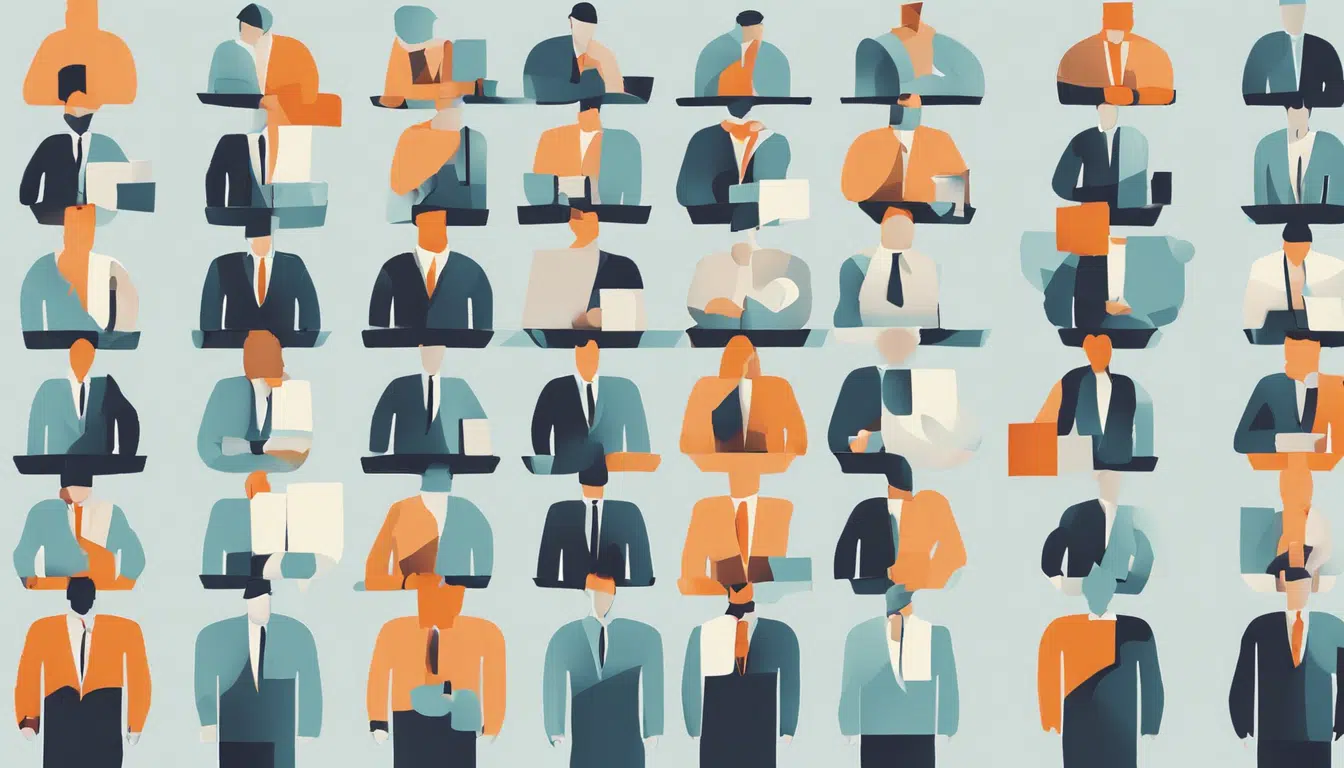You found our guide to how HR is different in small companies vs. large companies.
HR different in small companies versus large companies. The departments have unique roles, responsibilities, and challenges in different company sizes. For example, small companies may have a more hands-on approach, less formal procedures, and fewer resources than large corporations. The purpose of these differences is to fit the specific needs and dynamics of each company size. These differences are also known as “comparing HR in companies” and “HR department size differences.”
This article is similar to HR tips, HR guides, and HR automation.

This post covers:
- comparing HR in companies
- difference in HR size
- HR in large companies
- HR department size differences
- HR differences in companies
- HR in small companies
Let’s get to it!
How HR is different in small companies than large companies
From recruitment process to employee engagement, here are some differences between HR departments at small and large businesses.
1. HR Structure
In small companies, owners or managers often take on HR duties. The roles can be less specialized, covering tasks from recruitment to employee relations. In contrast, large companies typically have a complex, hierarchical HR structure.
This system often includes specialized roles. HR specialists do talent acquisition, compensation and benefits, labor relations, and organizational development. These professionals may work in teams or departments, strategizing and implementing HR policies on a larger scale. The difference in structure often reflects the business size and its resourcing needs.
2. Recruitment Process
Small companies recruit differently from large companies in several ways. Because of the firms’ smaller team sizes, the process is often less formal and more personalized. This structure can result in quicker decision-making and a stronger emphasis on cultural fit. Small firms may also have limited resources for extensive recruitment efforts.
Thus, these companies tend to rely more on employee referrals and networking to recruit new talent. In general, the recruitment process in small companies is more agile and adaptable than in large corporations. The personal approach and focus on cultural alignment can help ensure new hires fit well into the close-knit team.
Check out this list of books on recruitment.
Get our free team building toolbox
- icebreaker games
- bingo cards
- DIY guides
 by teams at FedEx, Amazon, Deloitte and 73,930+ others
by teams at FedEx, Amazon, Deloitte and 73,930+ others

3. Employee Onboarding
HR in small companies might be more flexible and tailor the process to individual employees’ needs. Within small companies, HR departments often have a more personalized employee onboarding process. These firms typically engage new hires in face-to-face interactions. Smaller HR teams can introduce new hires to every team member and provide hands-on training.
In contrast, large firms tend to emphasize consistency and efficiency. These companies usually have standardized onboarding programs. HR teams prepare induction materials and use technology for training. These two approaches show differences in the level of intimacy and customization.
Read about new employee onboarding practices.
4. Policy Creation
Creating policies in HR is essential for all companies, regardless of size. Small companies tend to have more flexible and informal policies due to their close-knit teams. Such policies enable quicker decision-making and adaptability to changes.
Conversely, large companies need structured policies to maintain consistency across departments and locations. Despite these variances, all firms benefit from clear, well-communicated policies that support their objectives.
The process of developing HR policies may differ between small and large companies. Ultimately, these rules aim to guide employees and foster a favorable work environment.
5. Training Programs
In small businesses, training programs are typically less formal and more hands-on. Business leaders often assume the role of trainers, sharing knowledge directly with employees. Small firms, due to their size and budget constraints, focus more on tailored on-the-job skill development.
In contrast, large organizations usually have structured, standardized programs delivered by specialized training teams. These programs may include eLearning modules, workshops, or multi-day seminars. Big companies’ larger budgets also allow them to use advanced training tools and systems.
Here are some of the top training companies for business.
6. Performance Review
In small businesses, the HR department often conducts performance reviews on a more personal level. Because of the close work environment, HR teams can understand each employee’s strengths and weaknesses thoroughly.
On the contrary, HR in large companies relies on metrics and data due to the sheer number of staff they handle. Also, these companies often use standardized assessment tools to ensure fairness and objectivity. In both settings, the goal is to foster employee growth and improve business productivity.
Check out this list of performance review phrases.
7. Conflict Resolution
Conflict resolution in small companies often involves direct communication between employees and managers. This process can result in quicker resolutions and a more personal approach to addressing issues.
However, large companies may have formal processes for conflict resolution, like HR departments or dedicated mediators. While these processes may take longer, they create a fair and consistent approach company-wide.
By understanding these differences, employees can navigate conflicts effectively regardless of company size.
8. Compensation Management
Compensation management in small companies can differ from that of large companies for various reasons. Smaller organizations may have fewer resources for competitive salaries and benefits than larger corporations.
Small businesses could offer flexible work hours or remote work options to attract and retain talent. Additionally, in smaller companies, employees may have a closer relationship with management. These bonds allow for personalized compensation discussions tailored to individual needs.
9. Employee Retention
Retaining employees is crucial for any firm’s success, regardless of HR differences in companies. In small companies, HR often takes on a more personalized role in employee retention strategies. The team focuses on creating a strong company culture and fostering close employee relationships. Small companies may offer unique perks and benefits tailored to each employee to enhance loyalty and motivation.
On the other hand, large companies typically have more resources to dedicate to employee retention programs. HR departments in large companies may use data to identify factors affecting turnover. Then, teams can use this information to create techniques that combat turnover rates.
Read more about employee retention.
10. Legal Compliance
In small firms, the HR’s role in legal compliance might involve direct, hands-on responsibilities. These workers may need a deeper understanding of laws relating to labor, employment, and health care. Larger corporations often have designated legal teams, allowing HR to focus on enforcing and communicating these policies.
11. Work Culture
Work culture in small companies often thrives on close relationships and a strong sense of community. Employees in smaller firms may enjoy direct communication with leadership. Such bonds foster a collaborative and transparent environment.
Large firms tend to have more formal structures and processes. This structure potentially leads to a hierarchical work culture. However, small companies may struggle with limited resources or growth opportunities compared to larger counterparts.
12. Strategic Planning
In small firms, strategic planning in HR often occurs on a more intimate, flexible level. With fewer employees, HR professionals can closely tailor strategies to individual needs.
However, in larger companies, strategic planning is typically more structured and systematic. HR departments need to consider lasting impacts and coordinate with various teams to put policies in place. While these steps might slow the process, they ensure a comprehensive, unified approach.
13. Leadership Style
Leadership style greatly differs between small and large companies. In smaller businesses, leaders often have a more personable and involved style. These executives work closely with their teams, leading to a flat organizational structure.
Leaders in large corporations often have a hierarchical leadership style, working through levels of management. These superiors usually depend on HR for employee engagement. This structure fosters a more formal and structured work environment.
Read about different styles of leadership.
14. Budget Constraints
HR departments in small companies often have stricter budget constraints than those in larger companies. Due to limited finances, small companies may not be able to invest in advanced HR technologies or professionals. As a result, HR staff in small companies often take on various responsibilities beyond typical HR functions.
Despite these obstacles, small companies can create a more intimate and cohesive work environment due to their size. Closer environments allow HR to interact more directly with employees.
In general, managing budget limitations in small companies demands creativity and strategic planning from the HR team.
15. Employee Benefits
Employee benefits in small companies may differ from those in large companies. Small companies might offer fewer benefits because of budget limitations. Employees may have limited health insurance options or retirement plans. Bigger corporations typically provide comprehensive benefits, including healthcare, retirement plans, and wellness programs.
16. HR Analytics
Human resources analytics in small businesses may not be as comprehensive as in big corporations. Small firms might depend more on qualitative information and basic measurements to make HR decisions. Big corporations have the capability for thorough data analysis. Despite HR department size differences, small and large businesses can both learn from HR analytics. Data can enhance employee satisfaction and productivity.
17. Employee Development
Due to limited resources, HR often plays a pivotal role in employee development in small companies. These workers are more hands-on, tailoring development programs to the individual’s skills and potential.
Large companies often have specialized teams responsible for the growth and learning of employees. These firms can afford advanced training programs. HR groups from big companies often use cutting-edge technology and professionals in the field.
18. HR Technology
Human resources technology is crucial for both small and large companies. Small companies typically use basic HR technology. Teams may use uncomplicated software for activities like payroll and maintaining employee records.
In contrast, large companies usually invest in advanced HR technology. Programs manage processes such as recruitment, performance management, and analytics. Ultimately, HR technology streamlines operations, boosts efficiency, and enhances the employee experience.
19. Organizational Design
Organizational design in HR involves how a company arranges its workforce, roles, and processes. In small companies, HR typically takes a hands-on approach with fewer specialized roles and an emphasis on multitasking. Small companies offer flexibility and diverse responsibilities for employees.
Conversely, large companies have more intricate organizational structures. HR can specialize in functions like recruitment, training, and compensation. These companies also provide resources for comprehensive HR programs tailored to various needs.
20. Talent Management
Talent management changes based on the difference in HR size. In small companies, talent management often requires individuals to fulfill multiple roles due to limited resources. HR professionals in smaller firms may handle recruitment, training, and performance evaluations at the same time. This hands-on approach allows for a more personalized focus on employee development and engagement.
Large companies usually have specialized HR teams for each talent management role. Such processes lead to more comprehensive strategies and processes.
21. Succession Planning
In small companies, HR tends to be more hands-on with succession planning. Direct interactions allow HR representatives to monitor potential leaders closely, allowing for smooth leadership changes.
Larger companies often use a more formalized system, focusing on statistical analysis and performance metrics. These firms may also devote specialized teams to succession planning.
22. Workforce Diversity
When comparing HR in companies, it is important to consider diversity. Workforce diversity means having a wide range of characteristics and experiences among employees.
In small companies, HR often has a more hands-on role in promoting diversity. Despite these connections, small companies may have fewer resources for specialized diversity initiatives than large corporations. However, firms can foster a strong sense of inclusion through close work environments.
Large companies can use more of their budget to focus on DEI initiatives. Resources include training programs, hiring practices, and team building exercises. Regardless of company size, embracing diversity can lead to increased innovation.
Read more about the benefits of diversity at work.
Final Thoughts
HR operates differently in small and large companies. Understanding these nuances can provide valuable insights for business owners, managers, and HR professionals. This knowledge helps tailor strategies that suit the unique needs of each organization. Moreover, learning about these differences fosters a better understanding of human resource management as a whole. Regardless of company size, effective human resource management is crucial for business success.
Next, check out our posts on HR outsourcing, HR training programs, and HR newsletters.



